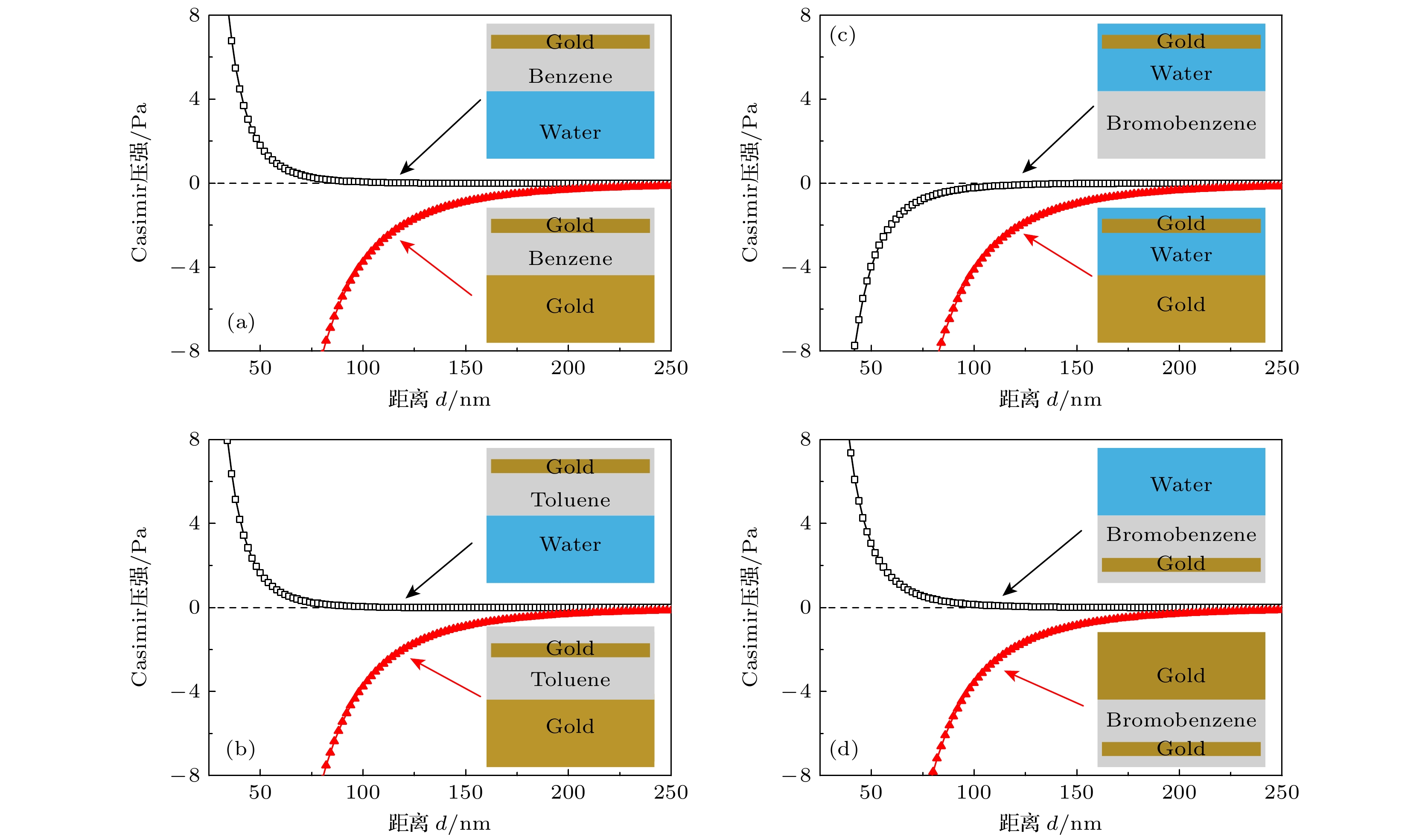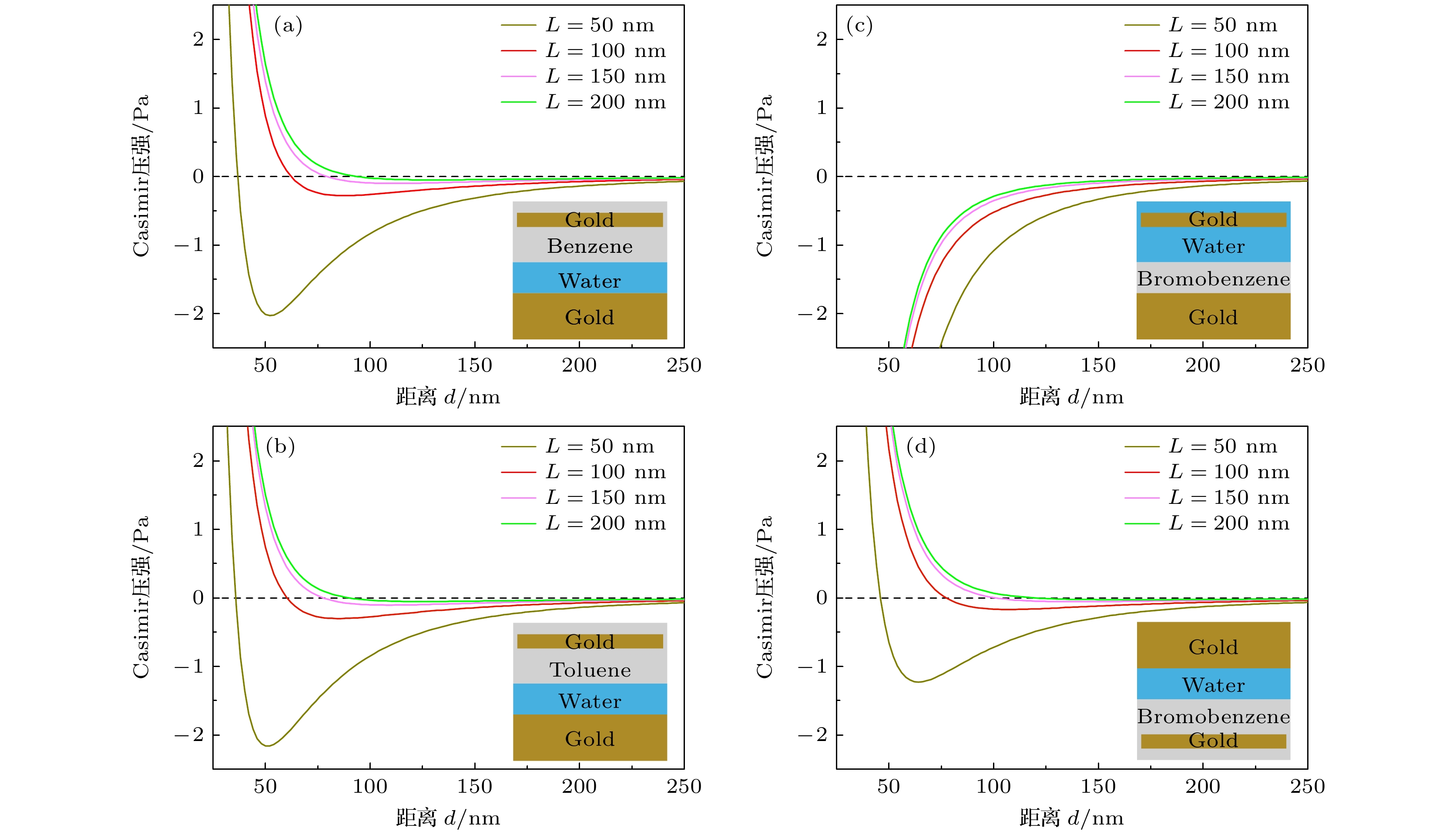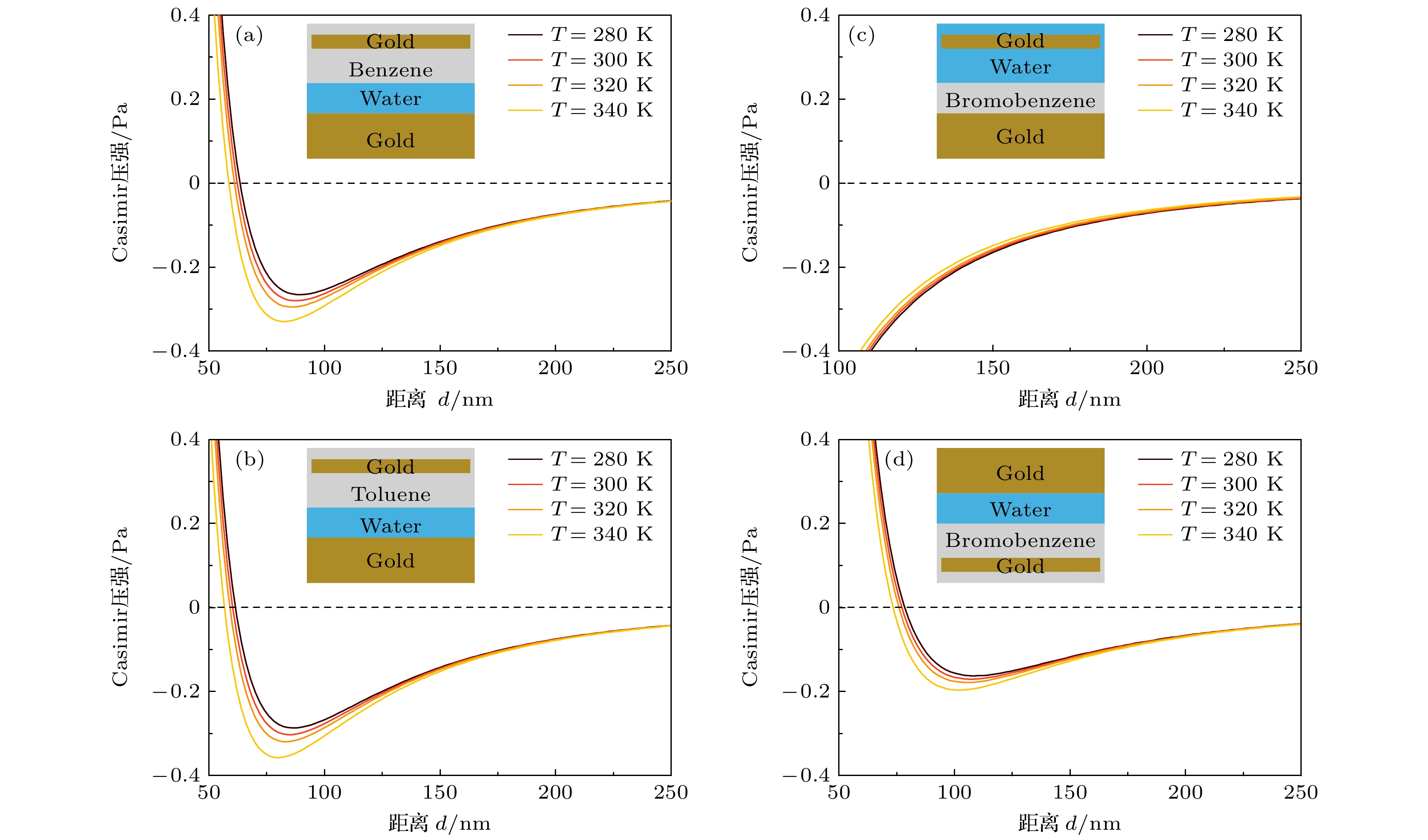-
The Casimir effect, a macroscopic manifestation of quantum phenomena, arises from zero-point energy and thermal fluctuations. When two objects are brought into close proximity, the Casimir effect manifests as a repulsive force, while at greater separations, it transforms into an attractive force. There exists a specific distance at which the Casimir force vanishes, which is referred to as the stable Casimir equilibrium. Stable Casimir equilibrium arises from the curve minimum value of the Casimir energy, which can create spatial trapping. The manipulation of stable Casimir equilibrium provides promising applications in fields such as tunable optical resonators and self-assembly. This work presents a scheme for achieving tunable Casimir equilibrium in a dual-liquid system. The system comprises a multilayered stratified structure with a gold substrate. Above the gold substrate, a stratified liquid system is formed due to the immiscibility between organic solutions and water. The lower-density solution is at the top, while the higher-density solution is at the bottom. Our results suggest that a stable Casimir equilibrium for a suspended gold nanoplate can be realized, when the suspended gold nanoplate is immersed in organic solution of toluene or benzene. Moreover, the height of the suspended gold nanoplate, determined by the stable Casimir equilibrium, can be precisely tuned by changing the thickness of the water layer. The effects of finite temperature and ionic concentration on the Casimir equilibria are also analyzed in this work. The results suggest that the separation height of Casimir equilibrium decreases with the increase of temperature. Interestingly, when the Debye shielding length is comparable to or smaller than the separation length, the ion concentration in water significantly affects the Casimir pressure allowing for extensive modulations of Casimir equilibrium. This work opens up a new avenue for adjusting Casimir equilibrium and has important applications in “quantum trapping” of micro-nano particles.
-
Keywords:
- Casimir equilibria /
- stratification /
- suspensions /
- quantum trapping
[1] Casimir H B 1948 Proceedings of the Koninklijke Nederlandse Akademie van Wetenschappen (Vol. 51) p793
[2] 苗兵 2020 69 080505
 Google Scholar
Google Scholar
Miao B 2020 Acta Phys. Sin 69 080505
 Google Scholar
Google Scholar
[3] Klimchitskaya G, Mohideen U, Mostepanenko V 2009 Rev. Mod. Phys. 81 1827
 Google Scholar
Google Scholar
[4] Lamoreaux S K 1997 Phys. Rev. Lett. 78 5
 Google Scholar
Google Scholar
[5] Mohideen U, Roy A 1998 Phys. Rev. Lett. 81 4549
 Google Scholar
Google Scholar
[6] Garrett J L, Somers D A, Munday J N 2018 Phys. Rev. Lett. 120 040401
 Google Scholar
Google Scholar
[7] Woods L, Dalvit D A R, Tkatchenko A, Rodriguez-Lopez P, Rodriguez A W, Podgornik R 2016 Rev. Mod. Phys. 88 045003
 Google Scholar
Google Scholar
[8] Rosa F S, Dalvit D A, Milonni P W 2008 Phys. Rev. Lett. 100 183602
 Google Scholar
Google Scholar
[9] Song G, Zeng R, Al-Amri M, Xu J P, Zhu C J, He P F, Yang Y P 2018 Opt. Express 26 34461
 Google Scholar
Google Scholar
[10] Grushin A G, Cortijo A 2011 Phys. Rev. Lett. 106 020403
 Google Scholar
Google Scholar
[11] Nie W J, Zeng R, Lan Y H, Zhu S Y 2013 Phys. Rev. B 88 085421
 Google Scholar
Google Scholar
[12] Chen L, Wan S L 2012 Phys. Rev. B 85 115102
 Google Scholar
Google Scholar
[13] Zhang Y C, Zhang H, Wang X X, Wang Y H, Liu Y C, Li S, Zhang T Y, Fan C, Zeng C G 2024 Nat. Phys. 20 1282
 Google Scholar
Google Scholar
[14] Jiang Q D, Wilczek F 2019 Phys. Rev. B 99 125403
 Google Scholar
Google Scholar
[15] Hu Y, Wu X H, Liu H T, Ge W X, Zhang J H, Huang X Q 2024 ACS Photonics 11 1998
 Google Scholar
Google Scholar
[16] Gong T, Corrado M R, Mahbub A R, Shelden C, Munday J N 2020 Nanophotonics 10 523
 Google Scholar
Google Scholar
[17] Bao F L, Shi K Z, Cao G J, Evans J S, He S L 2018 Phys. Rev. Lett. 121 130401
 Google Scholar
Google Scholar
[18] Chen L, Chang K 2020 Phys. Rev. Lett. 125 047402
 Google Scholar
Google Scholar
[19] Wang T B, Zhou Y, Mu H Q, Shehzad K, Zhang D J, Liu W X, Yu T B, Liao Q H 2022 Nanotechnology 33 245001
 Google Scholar
Google Scholar
[20] Yu T, You W, Wang T B, Yu T B, Liao Q H 2023 Results Phys. 52 106902
 Google Scholar
Google Scholar
[21] Wang L Q, Wu Y, Chen A X, Nie W J 2022 Results Phys. 41 105939
 Google Scholar
Google Scholar
[22] Wang Y P, Zhang Z C, Yu Y F, Zhang Z M 2019 Chin. Phys. B 28 014202
 Google Scholar
Google Scholar
[23] Esteso V, Frustaglia D, Carretero-Palacios S, Míguez H 2024 Adv. Phys. Res. 3 2300065
 Google Scholar
Google Scholar
[24] Rodriguez A W, McCauley A P, Woolf D, Capasso F, Joannopoulos J D, Johnson S G 2010 Phys. Rev. Lett. 104 160402
 Google Scholar
Google Scholar
[25] Ye Y Q, Hu Q, Zhao Q, Meng Y G 2018 Phys. Rev. B 98 035410
 Google Scholar
Google Scholar
[26] Liu X L, Zhang Z M 2016 Phys. Rev. Appl. 5 034004
 Google Scholar
Google Scholar
[27] Rahi S J, Kardar M, Emig T 2010 Phys. Rev. Lett. 105 070404
 Google Scholar
Google Scholar
[28] Rong J N, Chen L, Chang K 2021 Chin. Phys. Lett. 38 084501
 Google Scholar
Google Scholar
[29] Zhao R K, Li L, Yang S, Bao W, Xia Y, Ashby P, Wang Y, Zhang X 2019 Science 364 984
 Google Scholar
Google Scholar
[30] Ge L X, Shi X, Xu Z J, Gong K 2020 Phys. Rev. B 101 104107
 Google Scholar
Google Scholar
[31] Ge L X, Shi X, Liu L, Gong K 2020 Phys. Rev. B 102 075428
 Google Scholar
Google Scholar
[32] Toyama H, Ikeda T, Iizuka H 2023 Phys. Rev. B 108 245402
 Google Scholar
Google Scholar
[33] Ge L X, Liu K P, Gong K, Podgornik R 2024 Phys. Rev. Appl. 21 044040
 Google Scholar
Google Scholar
[34] Esteso V, Carretero-Palacios S, Míguez H 2019 J. Phys. Chem. Lett. 10 5856
 Google Scholar
Google Scholar
[35] Ge L X, Li B Z, Luo H, Gong K 2023 Phys. Rev. A 108 062814
 Google Scholar
Google Scholar
[36] Munkhbat B, Canales A, Kucukoz B, Baranov D G, Shegai T O 2021 Nature 597 214
 Google Scholar
Google Scholar
[37] Krasnov M, Mazitov A, Orekhov N, Baranov D G 2024 Phys. Rev. B 109 195411
 Google Scholar
Google Scholar
[38] Küçüköz B, Kotov O V, Canales A, Polyakov A Y, Agrawal A V, Antosiewicz T J, Shegai T O 2024 Sci. Adv. 10 1825
 Google Scholar
Google Scholar
[39] Lifshitz E 1956 Sov. Phys. JETP-USSR 2 73
[40] Van Zwol P, Palasantzas G 2010 Phys. Rev. A 81 062502
 Google Scholar
Google Scholar
[41] Rodriguez A W, Woolf D, McCauley A P, Capasso F, Joannopoulos J D, Johnson S G 2010 Phys. Rev. Lett. 105 060401
 Google Scholar
Google Scholar
[42] Munday J N, Capasso F, Parsegian V A 2009 Nature 457 170
 Google Scholar
Google Scholar
[43] Dou M F, Lou F, Boström M, Brevik I, Persson C 2014 Phys. Rev. B 89 201407
 Google Scholar
Google Scholar
[44] Sehmi H S, Langbein W, Muljarov E A 2017 Phys. Rev. B 95 115444
 Google Scholar
Google Scholar
[45] Fiedler J, Bostrom M, Persson C, Brevik I, Corkery R, Buhmann S Y, Parsons D F 2020 J Phys. Chem. B 124 3103
 Google Scholar
Google Scholar
[46] Wang Y F, Narayanan S R, Wu W 2017 ACS Nano 11 8421
 Google Scholar
Google Scholar
-
图 1 (a) 两不相溶液体中的Casimir悬浮示意图. 金纳米薄片距离液体分层界面为d. 溶液1的密度小于溶液2的密度; 而溶液2作为隔离层, 紧邻金属衬底且具有可调控厚度L. (b) 金、水、溴苯、苯和甲苯的介电常数随虚频率变化曲线
Figure 1. (a) Schematic diagram of Casimir suspension in two immiscible liquids. The distance between the gold nanoplate and the stratified liquid interface is d. The density of solution 1 is less than that of solution 2, while solution 2 acts as an isolation layer, close to the metal substrate and has a controllable thickness L. (b) Dielectric constants of gold, water, bromobenzene, benzene, and toluene change with the imaginary frequency.
图 2 悬浮金纳米薄片受到的Casimir压强 (a) 苯@水; (b) 甲苯@水; (c) 溴苯@水; (d)倒置的溴苯@水. 压力的正号表示排斥力, 负号表示吸引力. 金纳米薄片的厚度L0 = 40 nm, 系统温度T = 300 K
Figure 2. Casimir pressure acts on suspended metal nanoplates: (a) Benzene@water; (b) toluene@water; (c) bromobenzene@water; (d) tnverted bromobenzene@water. The positive sign of the pressure indicates repulsion, while the negative sign indicates attraction. Thickness of gold nanoplate L0 = 40 nm, and the temperature of system T = 300 K.
图 3 液体隔离层在有限厚度下, 双液体系统中金纳米薄片受到的Casimir压强 (a) 苯@水; (b) 甲苯@水; (c) 溴苯@水; (d) 倒置的溴苯@水
Figure 3. Casimir pressure acts on gold nanoplates in dual-liquid systems, where the layer thickness of liquid isolation is finite: (a) Benzene@water; (b) toluene@water; (c) bromobenzene@water; (d) inverted bromobenzene@water.
图 5 不同德拜屏蔽长度下, Casimir压强随距离d的变化曲线 (a) 苯@水; (b) 倒置的溴苯@水. 液体隔离层L的厚度设定为100 nm, 系统温度T = 300 K
Figure 5. Casimir pressure changes with separation d under different Debye screening lengths: (a) Benzene@water; (b) inverted bromobenzene@water. Thickness of the liquid isolation layer L is set to 100 nm, and the system temperature T = 300 K.
-
[1] Casimir H B 1948 Proceedings of the Koninklijke Nederlandse Akademie van Wetenschappen (Vol. 51) p793
[2] 苗兵 2020 69 080505
 Google Scholar
Google Scholar
Miao B 2020 Acta Phys. Sin 69 080505
 Google Scholar
Google Scholar
[3] Klimchitskaya G, Mohideen U, Mostepanenko V 2009 Rev. Mod. Phys. 81 1827
 Google Scholar
Google Scholar
[4] Lamoreaux S K 1997 Phys. Rev. Lett. 78 5
 Google Scholar
Google Scholar
[5] Mohideen U, Roy A 1998 Phys. Rev. Lett. 81 4549
 Google Scholar
Google Scholar
[6] Garrett J L, Somers D A, Munday J N 2018 Phys. Rev. Lett. 120 040401
 Google Scholar
Google Scholar
[7] Woods L, Dalvit D A R, Tkatchenko A, Rodriguez-Lopez P, Rodriguez A W, Podgornik R 2016 Rev. Mod. Phys. 88 045003
 Google Scholar
Google Scholar
[8] Rosa F S, Dalvit D A, Milonni P W 2008 Phys. Rev. Lett. 100 183602
 Google Scholar
Google Scholar
[9] Song G, Zeng R, Al-Amri M, Xu J P, Zhu C J, He P F, Yang Y P 2018 Opt. Express 26 34461
 Google Scholar
Google Scholar
[10] Grushin A G, Cortijo A 2011 Phys. Rev. Lett. 106 020403
 Google Scholar
Google Scholar
[11] Nie W J, Zeng R, Lan Y H, Zhu S Y 2013 Phys. Rev. B 88 085421
 Google Scholar
Google Scholar
[12] Chen L, Wan S L 2012 Phys. Rev. B 85 115102
 Google Scholar
Google Scholar
[13] Zhang Y C, Zhang H, Wang X X, Wang Y H, Liu Y C, Li S, Zhang T Y, Fan C, Zeng C G 2024 Nat. Phys. 20 1282
 Google Scholar
Google Scholar
[14] Jiang Q D, Wilczek F 2019 Phys. Rev. B 99 125403
 Google Scholar
Google Scholar
[15] Hu Y, Wu X H, Liu H T, Ge W X, Zhang J H, Huang X Q 2024 ACS Photonics 11 1998
 Google Scholar
Google Scholar
[16] Gong T, Corrado M R, Mahbub A R, Shelden C, Munday J N 2020 Nanophotonics 10 523
 Google Scholar
Google Scholar
[17] Bao F L, Shi K Z, Cao G J, Evans J S, He S L 2018 Phys. Rev. Lett. 121 130401
 Google Scholar
Google Scholar
[18] Chen L, Chang K 2020 Phys. Rev. Lett. 125 047402
 Google Scholar
Google Scholar
[19] Wang T B, Zhou Y, Mu H Q, Shehzad K, Zhang D J, Liu W X, Yu T B, Liao Q H 2022 Nanotechnology 33 245001
 Google Scholar
Google Scholar
[20] Yu T, You W, Wang T B, Yu T B, Liao Q H 2023 Results Phys. 52 106902
 Google Scholar
Google Scholar
[21] Wang L Q, Wu Y, Chen A X, Nie W J 2022 Results Phys. 41 105939
 Google Scholar
Google Scholar
[22] Wang Y P, Zhang Z C, Yu Y F, Zhang Z M 2019 Chin. Phys. B 28 014202
 Google Scholar
Google Scholar
[23] Esteso V, Frustaglia D, Carretero-Palacios S, Míguez H 2024 Adv. Phys. Res. 3 2300065
 Google Scholar
Google Scholar
[24] Rodriguez A W, McCauley A P, Woolf D, Capasso F, Joannopoulos J D, Johnson S G 2010 Phys. Rev. Lett. 104 160402
 Google Scholar
Google Scholar
[25] Ye Y Q, Hu Q, Zhao Q, Meng Y G 2018 Phys. Rev. B 98 035410
 Google Scholar
Google Scholar
[26] Liu X L, Zhang Z M 2016 Phys. Rev. Appl. 5 034004
 Google Scholar
Google Scholar
[27] Rahi S J, Kardar M, Emig T 2010 Phys. Rev. Lett. 105 070404
 Google Scholar
Google Scholar
[28] Rong J N, Chen L, Chang K 2021 Chin. Phys. Lett. 38 084501
 Google Scholar
Google Scholar
[29] Zhao R K, Li L, Yang S, Bao W, Xia Y, Ashby P, Wang Y, Zhang X 2019 Science 364 984
 Google Scholar
Google Scholar
[30] Ge L X, Shi X, Xu Z J, Gong K 2020 Phys. Rev. B 101 104107
 Google Scholar
Google Scholar
[31] Ge L X, Shi X, Liu L, Gong K 2020 Phys. Rev. B 102 075428
 Google Scholar
Google Scholar
[32] Toyama H, Ikeda T, Iizuka H 2023 Phys. Rev. B 108 245402
 Google Scholar
Google Scholar
[33] Ge L X, Liu K P, Gong K, Podgornik R 2024 Phys. Rev. Appl. 21 044040
 Google Scholar
Google Scholar
[34] Esteso V, Carretero-Palacios S, Míguez H 2019 J. Phys. Chem. Lett. 10 5856
 Google Scholar
Google Scholar
[35] Ge L X, Li B Z, Luo H, Gong K 2023 Phys. Rev. A 108 062814
 Google Scholar
Google Scholar
[36] Munkhbat B, Canales A, Kucukoz B, Baranov D G, Shegai T O 2021 Nature 597 214
 Google Scholar
Google Scholar
[37] Krasnov M, Mazitov A, Orekhov N, Baranov D G 2024 Phys. Rev. B 109 195411
 Google Scholar
Google Scholar
[38] Küçüköz B, Kotov O V, Canales A, Polyakov A Y, Agrawal A V, Antosiewicz T J, Shegai T O 2024 Sci. Adv. 10 1825
 Google Scholar
Google Scholar
[39] Lifshitz E 1956 Sov. Phys. JETP-USSR 2 73
[40] Van Zwol P, Palasantzas G 2010 Phys. Rev. A 81 062502
 Google Scholar
Google Scholar
[41] Rodriguez A W, Woolf D, McCauley A P, Capasso F, Joannopoulos J D, Johnson S G 2010 Phys. Rev. Lett. 105 060401
 Google Scholar
Google Scholar
[42] Munday J N, Capasso F, Parsegian V A 2009 Nature 457 170
 Google Scholar
Google Scholar
[43] Dou M F, Lou F, Boström M, Brevik I, Persson C 2014 Phys. Rev. B 89 201407
 Google Scholar
Google Scholar
[44] Sehmi H S, Langbein W, Muljarov E A 2017 Phys. Rev. B 95 115444
 Google Scholar
Google Scholar
[45] Fiedler J, Bostrom M, Persson C, Brevik I, Corkery R, Buhmann S Y, Parsons D F 2020 J Phys. Chem. B 124 3103
 Google Scholar
Google Scholar
[46] Wang Y F, Narayanan S R, Wu W 2017 ACS Nano 11 8421
 Google Scholar
Google Scholar
Catalog
Metrics
- Abstract views: 953
- PDF Downloads: 37
- Cited By: 0
















 DownLoad:
DownLoad:




